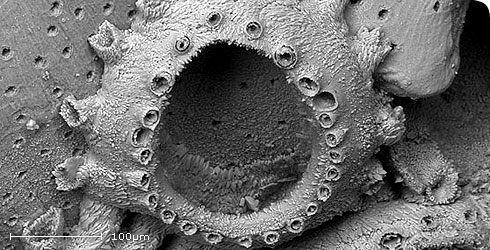Biology
Colonies are thin encrustations, superficially resembling lichens, attached to hard surfaces in the sea and growing up to about 1 centimetre in diameter.
It is not known how long colonies live but it is likely to be a few years or less.
Individual units of the colony - zooids - measure about 0.5mm in length.
The name disjunctus refers to the observation that the zooids not tightly packed together but instead are linked to their neighbours by short tubular chambers, an unusual feature in this kind of bryozoan.
Reproduction
Studies of other species belonging to the genus Cauloramphus have shown that embryos are brooded individually in special sacs within the feeding zooids.
Mature embryos are released as larvae that swim away from the parent colony to establish a new colony elsewhere. As the larvae probably survive for only a matter of hours, they provide a limited means of dispersal compared to some other species with long-lived larvae.
